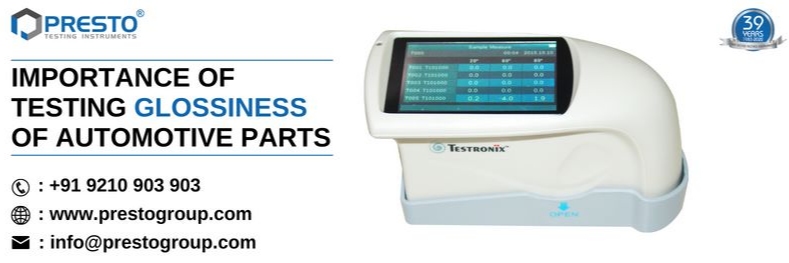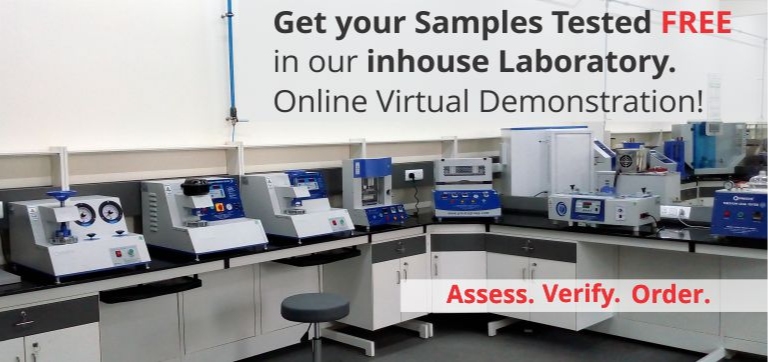Importance of testing glossiness of automotive parts

Gaurav Malhotra
The automotive industry has come a long way in terms of safety, emissions, and fuel efficiency. But one area that is often overlooked is the importance of testing the glossiness of automotive parts. Gloss measurement is the process of measuring the amount of light that is reflected off of a surface. This information can be used to determine the quality of a paint job, and it can also be used to adjust the manufacturing process to ensure that products meet customer expectations. If you are looking for a quality lab testing instrument to measure the glossiness of the surface, then we at Presto have designed a high-quality gloss meter triangle. This high-quality lab testing equipment comes with user-friendly controls and is easy to operate. It is portable, accurate and provides relative information about gloss on a surface, and measures the amount of reflected light from a surface. In this blog post, we will explore the role of gloss measurement in the automotive industry. We will discuss how the high glossiness of the surface can affect the life of the material. So, let us get started!
What is gloss testing?
Why is gloss testing important for automotive parts?
Do high gloss levels affect automotive parts?
All about Presto gloss meter-triangle
Features of Presto gloss meter-triangle
- The instrument is accurate, compact, portable, and sensitive.
- The tool is effective to measure the brightness of opaque glasses, plastics, ceramics,
- User-friendly and easy to operate
- Measurement standard conforms with JJG696 first class gloss meter working requirement
- Chromaticity Corresponding with CIE 1931(2°) under CIE C light source
- Standard Accessories available with the instruments are Power Adapter, USB cable, User Manual, software CD (except basic model), and Calibration Plate.
- Capacitive Touchscreen featured
- Software-based output of test results
- Simultaneous measurement of Triple standard angles- 20-degree, 60-degree, and 85-degree
- The facility of auto-calibrating data available
- The autosave function enables test data to be saved automatically
- Aesthetic design with ergonomics structure
- Display multiple sets of data for easy and quick comparison
- R 232/USB Communication Interface
- Auto power off function
- Data Management allows users to check, delete, export, or print record
- Protective cover to protect the measuring aperture
- Print facility available
- Portable and ease-of-use instrument with a handy battery
Technical Specifications of Presto gloss meter
- Measuring area of the instrument: 20°: 10x10mm, 60°: 9x15mm, 85°: 5x36mm
- The measuring range of the tool: 20°:0~1000GU, 60°:0~1000GU, 85°:0~160GU
- Division value: 0.1GU
- Measurement:
- Range: 0-10GU 10-100GU 100-1000GU
- Repeatability: ± 0.1GU ± 0.2GU ± 0.2%GU
- Reproducibility: ± 0.2GU ± 0.5GU ± 0.5%GU
- Different geometry degree measurement is also available.
- Chromaticity corresponding: CIE 1931(2º) under CIE C light source
- Touchscreen Display: Capacitive
- Communication Port: USB/RS 232
you may also like
- The Ultimate Guide to Lab Testing Equipment: Ensuring Quality with Precision Instruments
- GSM Calculator Guide: How to Measure Fabric, Paper & Plastic Weight
- What Is a Gloss Meter? Working Principle, Uses & Benefits Explained
- Applications of Tensile Testers in Plastic, Metal & Rubber Industries
- How UV Chambers Help Manufacturers Beat Sunlight and Weather Challenges
Recent News
- Paper & Packaging Testing Instruments
- Paint, Plating & Coating Testing Instruments
- Plastic & Polymer Testing Instruments
- Environmental Testing Chambers
- PET & Preform Testing Instruments
- Color Measuring Testing Instruments
- View Entire Range Instruments

Catalogue 2023
Get information about new product launches, research, innovation and endeavors at Presto.
download Free Copy
Get a Quote

